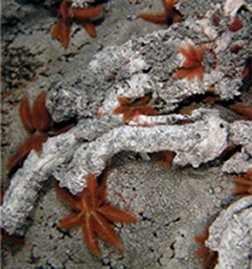Worms from deep-sea vents actually prefer water at temperatures near the upper limits of what animals are known to survive. An experiment, featuring a heated aquarium pressurized to 246 atmospheres, marks the first time researchers have directly tested vent worms’ temperature preferences.

Paralvinella sulfincola is one of the few worms that set up house in the hot zones of hydrothermal vents called chimneys. These deep-sea features spew hot fluids that come from within Earth. The team collected specimens of P. sulfincola from 1,800 meters deep in the northeastern Pacific.
In an aquarium, some of the vent dwellers moved to a spot with 50°C (122°F) water and stayed there for 7 hours, says Peter R. Girguis of Harvard University. A vent worm even survived a blast of 55°C water for 15 minutes, he and Raymond W. Lee of Washington State University in Pullman report in the April 14 Science.
Those are unusually high temperatures, even for a vent creature, says Girguis. For example, Rimicaris exoculata shrimp collected around vents all died in the lab at temperatures above 43°C.
In their natural habitats, the worms look like tipped-over palm trees. The burgundy, frondlike gills stick out of a tube that the worm secretes around the rest of its body.
Girguis and Lee used the robotic arms of submersible vehicles to collect the worms, brought the creatures to the surface, and immediately put them in an aquarium pressurized to mimic the conditions of the species’ native depths. The now-tubeless worms could travel across their new home.
To test temperature preferences, the researchers heated the box so that temperatures ranged from 20°C at one end to 61°C at the other. They then monitored where the worms settled.
Earlier tests of worms’ temperature tolerances were performed undersea. Craig Cary of the University of Delaware in Lewes hovered in a submersible and inserted probes inside the tubes of a different Pacific-vent worm, Alvinella pompejana. He recorded temperatures rapidly fluctuating between 40° and 90°C. That worm’s heat tolerance comes from its protective fleece of bacteria. Cary speculates.
Bruce Shillito of Pierre and Marie Curie University in Paris says that he’d like to test A. pompejana‘s temperature preferences in a setup similar to the one that Girguis and Lee used. However, Shillito says that when he brought samples of A. pompejana up from the depths, they arrived in “very rotten shape.”
Thomas Dahlgren of Göteborg University in Sweden, who studies deep-sea worms on dead whales, applauds the new efforts as “very important.” He says, “The deep sea is like a continent not yet discovered.”






